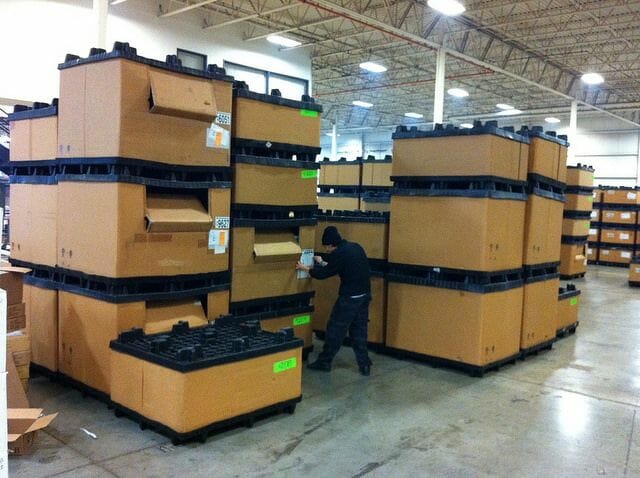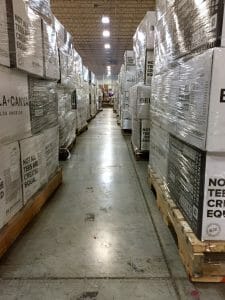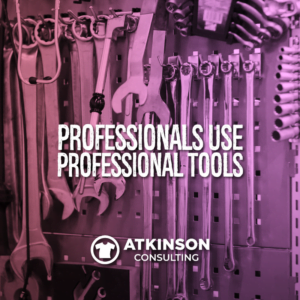If you could stop and think about it, how would you describe the most productive day in your shop? You know, where all cylinders are firing perfectly. All orders run smoothly. Staff knows exactly what to do. Zero mistakes. Everything ships perfectly, on time and complete.
Now freeze frame that notion.
That swirling, mystical thought is now your production goal. Or at least it can be. If your goal is 100% effectiveness, then all of the challenges that pop up diminish you from achieving that goal…what are you doing to prevent those challenges along the way? Below is a list of things that can affect your production on any given day. How are you tackling these in your shop?
Confusion. When one of your staff members can’t figure out what to do based on the information on the work order, this means you haven’t entered the order correctly. Information is the key to speed. Information also plays a big role in quality control as well. The more information available to your production folks, coupled with the training to understand it, means that they can make decisions on the floor that are correct and can go faster. Remember, if anyone in production has to stop what they are doing and walk the job up to the front of the shop and ask “Hey, what does this mean?”, then you aren’t doing it right. You absolutely need every possible question answered on that set of work order documents.
So what do you need? Basic information on the job for starters. A Ship Date, so Production understands the day it has to leave the building. The In-Hands Date, so Shipping knows when it is supposed to arrive to its destination. Style, Color and Size Information, so Receiving can make sure you have everything before the job starts. Your Art Department should create a Mock-up of the job, in color, showing the design on the shirt. Use a copy of your Art Approval Form if that’s easier. Included on the form are dimensions of the art, and key landmarks such as 3” from the collar, so Production can place the image on the garment correctly. Listed are all the ink colors or thread colors, in order. Get an easy to understand blueprint of what needs to be complete in the hands of those that have to do the work.
Training. Who has time for that? Well for one, you do. It just may not be a priority so you don’t put the effort into it. (I know, you have orders to ship) Suddenly, your printer or embroidery machine operator quits, leaving a very large skill gap in your shop. Or your lead customer service rep goes on vacation. Murphy’s Law will dictate that this will happen exactly at the wrong moment too. (Remember, those orders still have to ship!) However, six months ago if you spent some time working in another staff member into the position and rotated them in a few days a week, this challenge would be a little less stressful. (Now, the order ships without a problem, even when you are short staffed) Click here to read an article on how to build a cross training program in your shop. One great notion to have is that for every key task in your shop, there should be at least three fully trained people that know how to do it, on a very accomplished level. The trick is to work everybody into new positions. Keep the learning going!
Time. Every day you are fighting the clock. There are only so many hours in a day, and you can’t keep everyone chained to their work stations forever. Free pizza only works so many times. If your shop is lucky, you have more work booked than you can handle. So how do you get more orders through the pipe every day?
First, you have to make things easier for your staff to do the right thing. Does your production lead know what job to work on next? Is the work order, inventory, screens, ink or thread staged with the job so all they have to do it run it? When you schedule jobs to equipment, are you running similar jobs back to back so the operator doesn’t have to change boards on the press, or cones of thread on the machine? Does everyone have the right tools for their job, or does a worker have to search for ten minutes to find a tape gun to seal a box?
All of these extra minutes add up every day. Do yourself a favor and just stop and observe your production floor quietly for a bit. What do you see? Make the small changes that will help you accomplish more every day. Get the right people for the right jobs. Update equipment when you can. Newer machinery tends to run better. A robust continuous improvement program will work wonders, but you have to get started. Talk to your employees and find out where their pain points may be. Alleviate the pain.
Organization. This is a pivotal point. Keeping your shop organized can be the make or break point for pushing more orders through daily. Some shops look like a hurricane just blew through. Others are surgical room clean. Most are in the middle somewhere. If you think about your shop floor as real estate, the prime positions that you need to attend to are around where any work is being performed. Make sure those areas are neat, clean, tidy and ready to work. All unnecessary stuff is removed and stored somewhere else. Keep tools and production items handy, and have duplicate sets for every work area. You might think you are saving money by only having one calculator out in the shop, but you are just putting a ridiculous burden on your staff. This goes for any item that everyone uses. Get off your wallet cheapo. Make it easy for people to do the right thing.
Also, as everything should have its own place on the shop floor make sure you stage and organize your inventory for jobs too. If you use Work Orders that have a sequential numbering system, organize everything using the last digit of the Work Order number. Divide everything up into rows. For example, if your Work Order number is 123456, the job would be staged in the 6 row. Now anyone can find it, and know exactly where to look. This works for partially received orders too. Have an area where you divide up jobs by number so you can quickly locate a box when the rest of the goods come in. If your job uses more than one box, make sure you label the boxes 1 of 3, 2 of 3, 3 of 3, etc. This helps determine quickly what you need and assures that you can locate the entire product should a box get out of order somehow.
All of your screens, hangtags, labels or anything that has to do with the order should be labeled as well. Organize everything and have a standard place for storing it until the job requires it. This is a discipline that works great for a few weeks, but if you don’t keep up with it the program can unravel on you. Keep the leadership going. Insist on excellence.
Scheduling. Ah, the hidden gem of the industry. How do you know how to get it all handled? Experience plays a good part. Understanding your shops capabilities, skill and speed of your staff, equipment standards, and just generally how long things take to do. You can get this information by keeping production logs for averages. Although some jobs are blazingly faster, and others print along like glaciers moving through a valley, the average for screen-printing on an automatic is about 400 an hour for a full size print, and 60 an hour for a manual. This is factoring all types of set ups, color counts, and garment types. For printing, unless you are just running one big job, if you can keep your presses printing over 70% of your day, that’s doing great. The hard work is in minimizing downtime. Like a NASCAR pit crew, the faster you can turn jobs over, the more orders you can print a day. A good operator and press crew should be able to set up in under five minutes a screen easily. What are the average times for your shop? If you don’t know, start measuring to get this information. Use this for scheduling purposes. On a good day, you’ll beat the average. On others, you’ll get snake-bit and a job or two wrecks your entire day. Production happens.
Once you get a good grasp on what your capabilities are normally, you can schedule your jobs based on this information. Do this in advance, and you’ll shortly discover how to get everything scheduled per day, for all your equipment. This is going to constantly change during the day, so you’ll need to be very flexible, as there’s always that rush order that drops in, or a screen pops on press. The trick is to be ready. Give your press crews the expectations on what they have to print each day with a list, and make their jobs easier by lining up their jobs for them, in order, by their equipment. Stage everything for the job for them. Your operators should never want for anything. If you see a press operator hunting around the screen room for a frame for his next job, your shop floor manager isn’t doing his job.
Once your schedule is posted, train everyone on how to read and understand it. Once you start reaching your maximum production capabilities you will need to start discussing overtime, running a second shift, working weekends or possibly contracting the jobs out. The important thing is to be disciplined and trust the system. Use real due dates. For an in-depth look at scheduling click here.
Supply Chain. Face it; we buy a lot of stuff for our shops. The absolute one thing you can’t do it is run out of something, especially during a busy season or long production run. Check your stock levels often, and make sure you always have enough on hand. However, your supply chain is more than just where you get your consumables. They are also the repository of knowledge about how the stuff should work. If you are having problems with something, make sure you immediately call and start asking questions. Chances are you aren’t doing something correctly. Bring in your rep for some on-site training. Experiment occasionally with a new product or technique. A few times a year, your supply distributors may have an open house or some training at their location or another shop nearby. Absolutely go to this. Yes, I realize you have orders to ship and are busy (See comment above), but the training and the ideas presented at these events could save you from heartbreak one day in production. Occasionally you have to take the time to sharpen the saw. Here are some more thoughts about how important your supply chain is to your business.
People. While I’m an optimistic person and give people plenty of chances to succeed, I’ve seen the negative effect a bad seed can have on the rest of your staff. Generally speaking your company will act and behave however you let it. Once a culture gets ingrained into a shop, it’s really hard to change that. Regardless of skill or position, try to hire people that want to succeed, that have inner drive and a positive mental focus. There is a big difference between people that just want a job, and people that want to kick butt every day. While we all use equipment, computers, software and other devices to get our work accomplished every day, your company’s success is tied 100% to the people you employ. Got a bad apple working for you? Get rid of them and hire someone else. Finding the right talent is difficult, especially in the decorated apparel industry as nobody really knows how to do our jobs. We have to train them. Give them feedback during your performance review process…don’t just make it to be about attendance. Find the right person that fits your company culture, and then train them with the skills you want them to have. Let the butt kicking begin!
Your most productive day is ahead of you. We all have a competitive nature. More is good. However, don’t let the craze of shoving more through the pipe come at a sacrifice of quality, or at the expense of your staff. Think things through and plan.





19 comments
Joyce Jagger
Marshall, It is great to read something about production. I have been following your blogs and your articles in Impressions and they are great! If only more people would pay attention. I am The Embroidery Coach and I teach embroiderers how to run their business and help them organize their shops. It works the same for the small shops as it does for the big shops, just on a much smaller scale. I work with both large shops and small shops and organization is the same, sometimes using different, more simplified tools.
I cannot believe how disorganized so many shops are but it gives me a big thrill to go in and help them get it all straightened out and going on the right track.
At one time I had a large embroidery shop and I was very adamant on keeping everything organized, the production on track and keeping customers happy!. To me it only makes sense, but many people, I have found, do not have that skill and it is very hard for them to get their businesses organized.
Thanks again for writing an article that talks about production. It is rare to find one.
atkinsontshirt
Joyce:
Thanks for your continued readership and taking the time to comment!! Love it. It really makes me happy that others get something out of my articles, and share in the same blood, sweat and tears. This industry really isn’t that large and we can all learn from each other. Thanks again!!
-M
Kara Goodman
I love your blogs and always learn something new that I can use in my business. Can you do an article about a “1 man shop”? I run a small print shop myself 95% of the time. My husband comes in on his days off and I also have a few friends I have taught to do some things around the shop to help out during the crazy busy seasons. My problem is being a “1 man shop”, some days I feel like I can’t even get to the printing press because of emails, quotes, sorting boxes, ordering supplies, answering the phone, talking to customers that drop in, etc. How do you organize your day so that the mundane task are getting done along with doing the actual jobs?
atkinsontshirt
Kara:
Thanks for reading and commenting!! Sure, I can probably write something that’s tailored for a smaller shop, but to be honest I’ve always just run the big boys. Let me think about it and look for something in the future… Thanks again!! -M